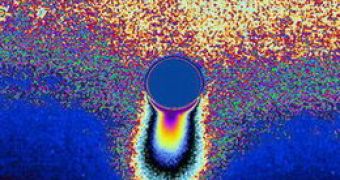Ancient radioactivity is suspected to have fired billions of years ago the forces that fuel geysers on Saturn's moon, Enceladus. "Deep inside Enceladus, our model indicates we've got an organic brew, a heat source and liquid water, all key ingredients for life," said Dr. Dennis Matson, Cassini project scientist at NASA's Jet Propulsion Laboratory, Pasadena, California. "And while no one is claiming that we have found life by any means, we probably have evidence for a place that might be hospitable to life."
In 2005, Cassini orbiter's cameras detected geysers on Enceladus spitting off water vapor and ice crystals from its south polar region, which is something puzzling as Enceladus is just a tinny ice ball that theoretically could not generate the heat amount necessary to fuel such eruptions.
A new hypothesis sustains that the radioactivity within Enceladus shortly after it emerged may have triggered the long-term heating of the moon's core, process that still continues today. "Enceladus is a very small body, and it's made almost entirely of ice and rock. The puzzle is how the moon developed a warm core. The only way to achieve such high temperatures at Enceladus is through the very rapid decay of some radioactive species", said Dr. Julie Castillo, the lead scientist developing the new model at JPL.
The new model points that young Enceladus compassed rapidly decaying radioactive isotopes of aluminum and iron, whose decomposition over about 7 million years would generate huge heat amounts, consolidating the rocky material at the core wrapped in the ice shell.
The remaining, more slowly decaying radioactive elements in the core could continue to generate heat and melt the moon's interior for billions of years.
This model also explains how Enceladus generated the molecules in the plume, predominantly water vapors with minor levels of gaseous nitrogen, methane, carbon dioxide, propane and acetylene.
Nitrogen presence puzzled the scientists, as it could have been present in Enceladus' original composition.
The new model suggests nitrogen is the result of the ammonia decomposition deep within the warm moon core. Ammonia decomposes at temperatures as high as 577 degrees Celsius (1070 degrees Fahrenheit). These conditions also help the formation of simple hydrocarbon chains, basic "bricks" in life molecules.

 14 DAY TRIAL //
14 DAY TRIAL //